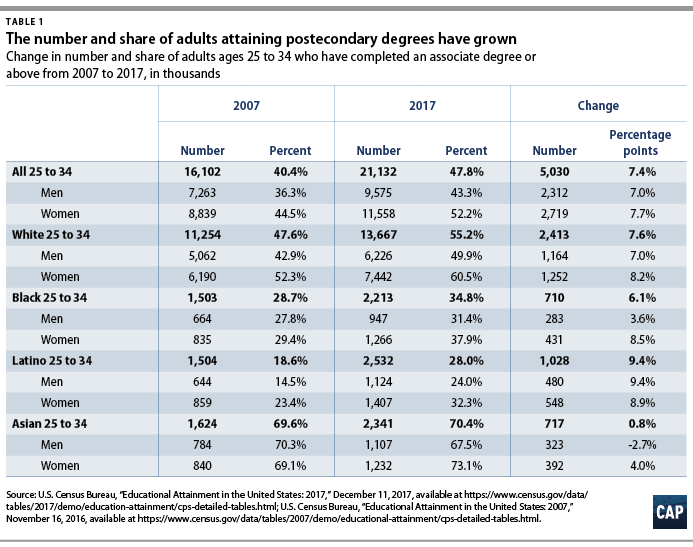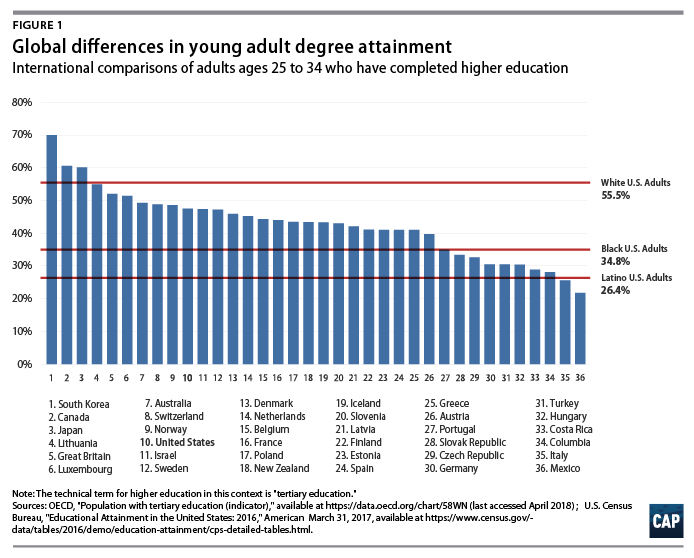Sky high prices. Student loans that are burdensome for far too many. Large numbers of students who start college but never finish. Look at the headlines in higher education today, and you’ll be hard pressed to find anything but bad news.
These are grave concerns. However, they’re not the whole story of American higher education. The United States has made progress on improving college attainment. According to data from the U.S. Census Bureau’s American Community Survey (ACS), the percentage of adults aged 25 to 34 who earned an associate degree or more grew from 40.4 percent in 2007 to 47.8 percent in 2017. That represents more than 5 million additional Americans with a college degree over 10 years.
Digging deeper into this boost in attainment reveals two important stories: one an achievement, the other cause for significant concern.
The undercovered Latino success story
The census data show that recent Latino success in higher education continues to be the most impressive and underdiscussed accomplishment in postsecondary policy. From 2007 to 2017, the percentage of young Latinos who earned a college credential rose 9.4 percentage points. That’s the largest change of any racial group reported in the ACS data.
Both women and men share in these gains. Since women are more likely to enroll in and finish college than men, it is particularly impressive that, at 9.4 percentage points, Latino men saw the largest gains of any racial and gender subgroup.

To be fair, these impressive jumps represent improvement from a level of attainment that was quite low. Even after all these gains, in 2017, just 28 percent of Latino young adults had finished college—a rate half that of their white peers. But in the span of nine years, the number of college-educated Latino young adults increased by nearly 60 percent. That translates into more than 1 million more college-educated Latinos.
Nor are these gains only limited to associate’s degrees. The percentage of Latinos earning a bachelor’s degree or higher went up by 6.7 percentage points, while the share earning just an associate degree only went up 3 percentage points.
While the overall low level of Latino attainment should by no means satisfy the country, these impressive gains in less than a decade represent substantial progress that merits further study in order to see what is working with serving this population. It’s also important to keep a close eye on states that enroll large numbers of these students—particularly California, Texas, Florida, and New York to ensure no policy changes occur that could arrest this progress.
The bad news
Unfortunately, the attainment story for black young adults, particularly men, shows that the higher education system still fails these individuals. The share of young black adults who attained a college degree rose just 6.1 percentage points from 2007 to 2017. The only group with worse results were Asian adults, but this group has an overall college attainment rate of 70.4 percent, double that of black adults.
The results for black men are particularly distressing. They saw an attainment increase of just 3.6 percentage points. That’s roughly half the rate of change for white men. As a result, the attainment gap between white and black young adult men grew over the last 10 years.
The story is more positive for black women, whose 8.5 percentage point increase was slightly above the growth rate for white women. However, despite this growth, young black women still have attainment levels 9.8 percentage points below the overall population.
Improving international competitiveness requires closing attainment gaps
Despite improvements in attainment rates, America still ranks 10th in the world in the share of young adults who have finished college. Equity gaps are a major reason for this result. America’s white young adults have attainment levels that would rank fourth internationally. However, black and Latino attainment would rank 28th and 35th internationally, respectively.

To get a sense of how much equity gaps hold back America’s international competitiveness, consider that just halving the difference in attainment between white students and key subgroups would make the United States one of the five most-educated countries.
Conclusion
Completing college is one of the best paths to lifelong economic success in this country. The good news is that millions more Americans have achieved this milestone over the last decade and that Latino young adults are making impressive strides to close the gap with their white peers. But these accomplishments are still not enough. If attainment gaps persist by race, the best ticket to the middle class will continue to be inaccessible for far too many Americans.
Ben Miller is the senior director for postsecondary education at the Center for American Progress